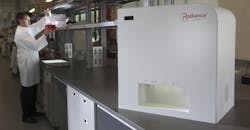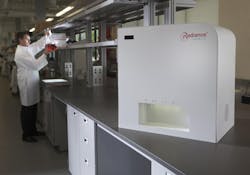The United States Naval Research Laboratory (NRL) has patented a laser-based system for the autonomous separation and characterization of streams of human cells, in search of pathogens and disease. The microfluidic system measures the optical force of individual cells to detect changes within cells that are part of a larger cell population, and in this way making it possible to detect diseases much faster than current detection methods.
The Radiance laser-based system (see figure) employs fluid flow to drive particulate samples through a network of flowing channels, followed by laser light to interact with the particles and reveal optical force by means of radiation pressure. “This force, when balanced against the fluidic ‘drag’ on the particles, results in changes to the particle’s velocity,” explained Dr. Greg Collins, head of NRL’s Chemical Dynamics and Diagnostics branch. “This can be used to identify differing particles or changes within populations of particles based on intrinsic differences in cell biochemistry, morphology, and deformability.”
The Radiance laser-based instrument can characterize and sort individual cells by measuring their optical force, allowing researchers to detect and measure viral infection of mammalian cells quickly and effectively. (Photo courtesy of LumaCyte)
The system should offer aid to many areas of R&D, including cancer studies and development of new drugs. As Collins explains, the differences in optical pressure can be used as a means of separating and characterizing particles: “When samples are optically retained within the system, squeezed between the fluid flow and the retaining laser force, the extent to which they are retained, deformed, or ‘squished’ by the force of the laser and the fluid flow is related to their composition and biomechanical structure.”
About the Author
Jack Browne
Technical Contributor
Jack Browne, Technical Contributor, has worked in technical publishing for over 30 years. He managed the content and production of three technical journals while at the American Institute of Physics, including Medical Physics and the Journal of Vacuum Science & Technology. He has been a Publisher and Editor for Penton Media, started the firm’s Wireless Symposium & Exhibition trade show in 1993, and currently serves as Technical Contributor for that company's Microwaves & RF magazine. Browne, who holds a BS in Mathematics from City College of New York and BA degrees in English and Philosophy from Fordham University, is a member of the IEEE.


